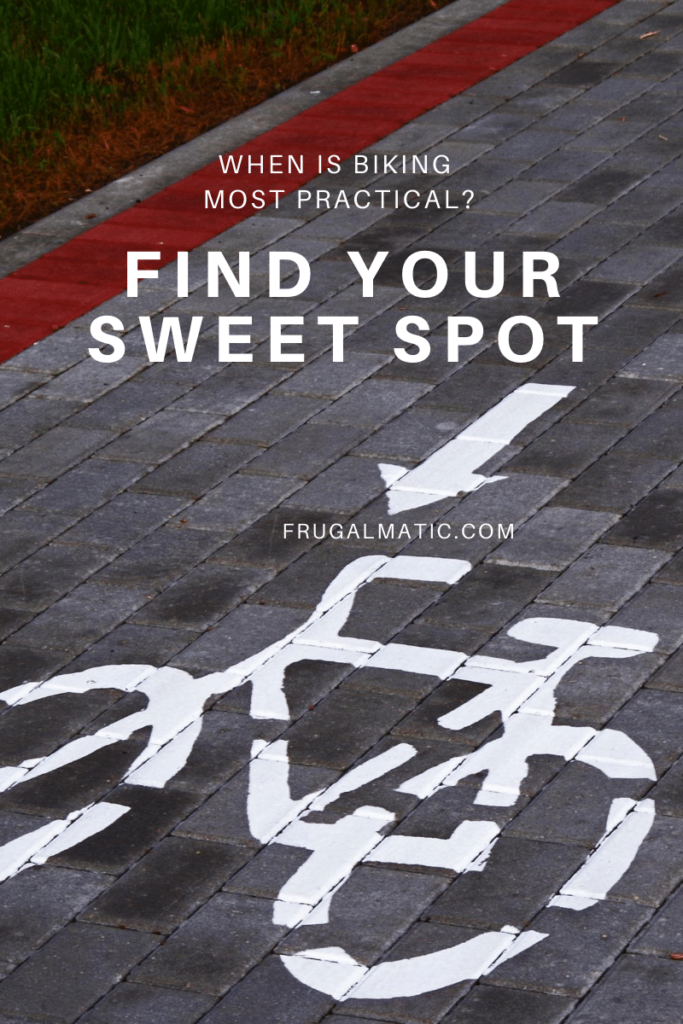This post was last updated on August 11th, 2022 at 11:23 am
Last week, I launched this blog with a post on what it means to be frugalmatic. If frugalmatic were a real word, the dictionary entry might say: Maximizing the value of everyday activities by realizing their indirect benefits.
One of the best frugalmatic examples is biking to work. The direct benefit is getting to work. The potential indirect benefits include the exercise you get and the money you save by not driving.
How to calculate your ratio
You can determine how “frugalmatic” your bike ride might be with this simple formula: Divide the amount of time it takes to bike to work by the amount of time it takes to drive to work (or take mass transit). The closer that ratio is to 1, the more practical biking becomes.
If your ratio is exactly 1, it probably means you live about a city block from your work. That’s because it takes about the same amount of time to drive a city block as it does to bike, and a bike is even faster when factoring the time it takes to park a vehicle.
During my last job, my ratio was about 2, meaning it took me twice as long to bike as it did to drive to work. I liked the arrangement, as it guaranteed me about 20 minutes (a roundtrip) of exercise each weekday.
When biking becomes impractical
The higher the ratio, the more exercise you’ll get. But, of course, you don’t want to bike too far to get to work. As the ratio creeps closer to 3, biking to work becomes less practical. At 5, you’re likely facing a 4-hour, one-way ride. I don’t know too many people who can spare 8 hours a day for their work commute. Also, the farther you must bike, the sweatier you’ll likely get, which creates another problem for bikers. It’s not feasible for most people to arrive at work a sweaty mess.
To understand how this ratio functions at different distances, use Google Maps’ “directions” feature. It shows travel times for walking, biking and driving. If you decide to try biking, I recommend a practice run to test the accuracy of Google’s travel time estimate. You will want to determine your route’s suitability for biking. For instance, potholes that merely annoy a driver can be downright dangerous for a biker. Also, figure out a system for transporting your work supplies. It can be as simple as a backpack. If you plan to ride throughout the winter (and I encourage you to try it!), you’ll likely need to make several additional adjustments.
Keep in mind, if biking to work isn’t an option for you, you might also consider a combination of walking and riding mass transit to work. Or, if you have a bike carrier, you can brink your bike to work by parking your vehicle a few miles from your office and then biking the rest of the way.

Using the ratio for other life tasks
The ratio can be applied, too, to other life tasks, such as mowing the lawn. How long does it take to mow your lawn with a push mower versus a self-propelled mower? How about a push mower versus a riding mower? If mowing an acre of grass takes 2 hours by a push mower and 45 minutes with a riding mower, your frugalmatic ratio is 2.6. That push mower would give you a heck of a workout, but do you have the 1 hour and 15 minutes to spare? On the other hand, do you have the money to buy and maintain a riding mower? The answers to these questions depend completely on the individual.
Ultimately, frugalmatic people seek opportunities to both save money and incorporate physical activity into their daily routines. They are aware of the indirect benefits of doing certain tasks in a certain way for a certain period of time. While there’s no single “correct” way to go about being frugalmatic, it’s a balance between being fruglamatic and being practical. It’s great to want to get more physical activity, but that activity needs to fit into your daily routine. You likely cannot swap a 45-minute car commute for a 3-hour bike ride. But if your drive to work is only 5 minutes, biking to work might add only 10 or 20 minutes to your schedule. The important thing is to analyze your routine and seek out opportunities to sit less and move more.
Share this article with someone else, and let them know how you’re finding more ways to be physically active.

